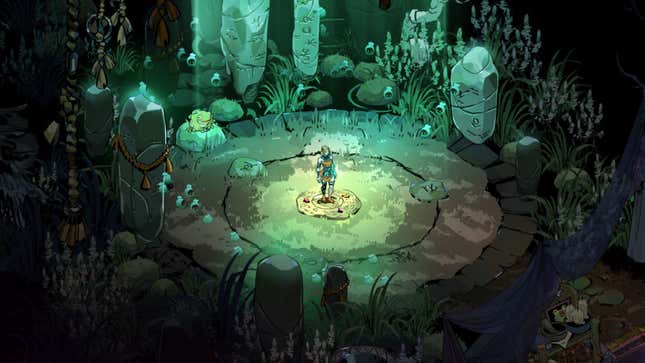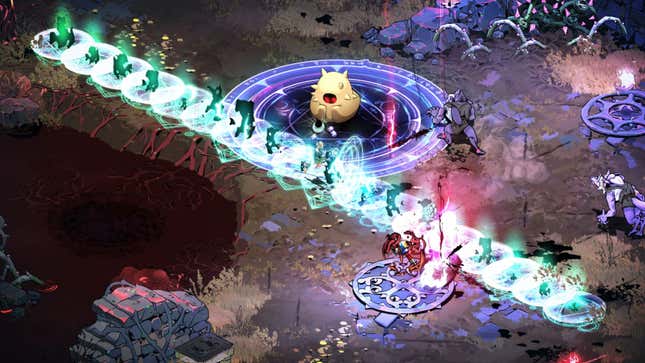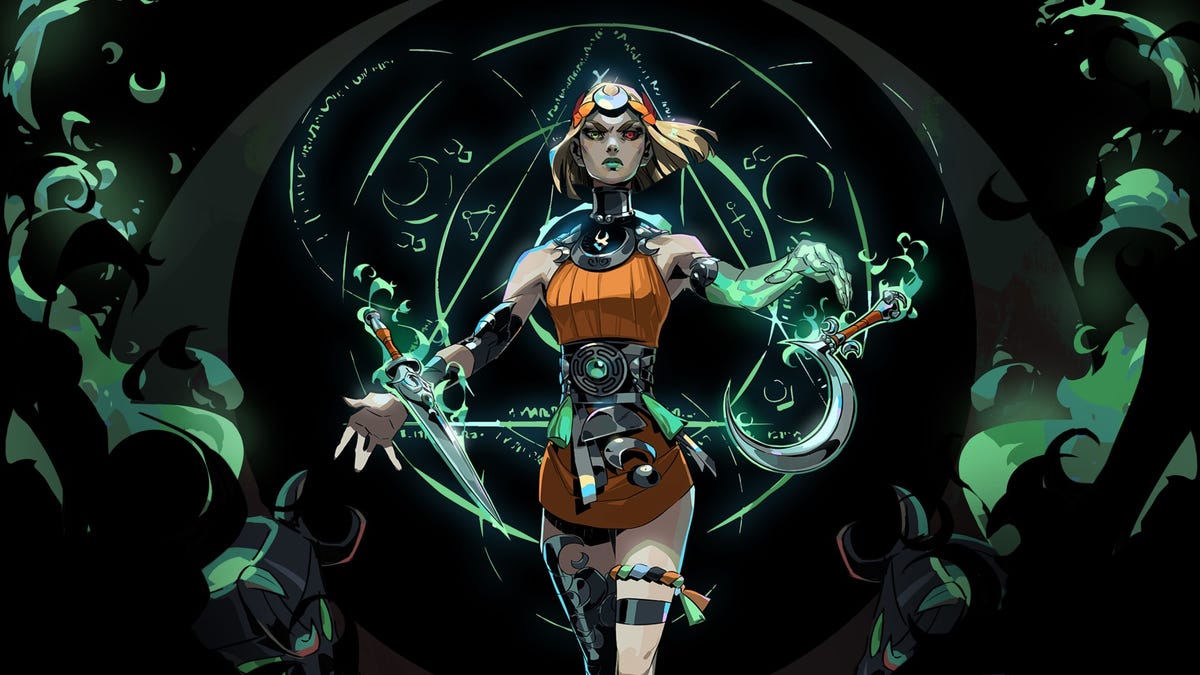Playing Hades in the throes of the anguish that was 2020 was exactly the balm I needed. It was the rare roguelike that worked for me, marrying a story that toyed with a pantheon and mythos I’d loved since childhood with some of the most white-knuckle combat I’d experienced in a game. Whether I wanted to check out for 20 minutes or 20 hours, Hades was there, and it was replete with narrative twists and turns, excellent combat, and best-in-class art to pass the time and delight me. It truly was, and remains, one of the most brilliant things I’ve ever played.
Hades 2 is the sequel I least expected, considering the high standard the first had already set. I literally can’t believe Hades 2 is like this, despite having had it for some time now. After a few dozen hours with the current early access build and multiple attempts on Chronos’ life, I’m in utter disbelief. It somehow polishes rough edges I never even noticed while playing the near-flawless predecessor, and though it is unfinished (it’s an Early Access release), Hades 2 is a force.
A fresh new face
Where to start? Why not with where the game starts: as its new protagonist Melinoë and the player embark on their first run. Hades 2, much like its clever predecessor, cuts right to the action yet makes it very clear that it isn’t a simple rehash of a winning formula. Hades 2 immediately expands on the first game’s range of abilities by bestowing Melinoë with new skills thanks to her connection to Hecate, the goddess of witchcraft who acts as a maternal figure and mentor for our new heroine.
By the time that Hades launched into 1.0, the game’s protagonist Zagreus had access to a stacked armory of weapons, but his own moves were fairly restrained. He had an attack, a heavy move, a dash and a throwable cast. By comparison, Melinoë has at least double the moveset, since she can now charge each of her techniques into what the game calls Omega moves, sometimes boasting different effects and doing greater damage. Instead of a separate heavy attack though, Mel can throw down a casting circle whose effects are augmented according to the boons that she collects over the course of a run. This change, as well as a dramatically slower dash, often makes Mel feel slower than Zagreus ever was, but also much more powerful and tactical. Zag was a straight-up brawler through and through, and brazenly blasting through enemies proved to be the winning tactic in most of my successful Hades runs. This no longer feels like the case in the follow-up. Melinoë feels like she’s more emboldened to be tactical, and Hades 2 certainly plays better when I use her kit to the fullest extent.

Melinoë also has quite the armory, including a pair of twin blades that have quickly become my favored weapons. She also has an interesting pair of torches that necessitate the constant use of her magick and a ranged skull weapon, as well as a more traditional ax. Though I’ve yet to play with all of them and their numerous aspects equally, I’ve seen enough to suggest that Supergiant most assuredly didn’t rest on its laurels developing new ways to cut your way through hell. When you aren’t fighting though, Hades 2 also boasts a number of supplementary systems and features, like resource farming, crafting, additional currencies, base-building, and even steamy social interactions, that make the current early access build impressive and also massively daunting.
Melinoë isn’t just Zagreus’ mechanical opposite though, she is also his little sister, and her desire for a relationship to the House of Hades is a central thrust of Hades 2. It’s an inspired inversion of Zag’s desire to break free of the very same chains in the first game. Zag was a firebrand and a smartmouth, which in turn made for a charming and roguish protagonist. Mel isn’t too far behind, at least as far as her mouth is concerned, but she leads with sympathy and a determination that strikes a far more resonant chord with me. I never really wanted to rip Zag from his family, even if that was never the real goal of Hades, but I do want to reunite Mel with the family she was deprived of.
A greater pantheon goes to war
Speaking of, Mel and Zag do have one other thing in common: neither of them is particularly close to their larger family at the outset of their adventures. For reasons that are revealed over the events of Hades 2, Mel was also raised apart from her aunts, uncles, and numerous cousins on Mount Olympus, who once again return in the sequel to forge relationships with Mel and strengthen her over the course of a run. Favorites like Aphrodite, the embodiment of love and sex, return alongside Zeus and the dazzling Apollo, while Hestia and Hephaestus make incredibly impactful debuts and broaden the spectrum of Hades’ limited view of beauty.
On the matter of boons, Hades 2’s pantheon is even greater than their last outing. Similar boons and some overpowered gods (RIP Athena) have fallen away to make room for a greater range of differentiating abilities. Hestia’s flames singe enemies over time, for example, rewarding players who take their time chipping away at foes. This comes in stark contrast to many of Athena’s abilities in the first game, which often made players invulnerable and emboldened them to dash into the fray. Demeter’s freezing capabilities have always felt powerful, but her late-game addition in Hades muted the arrival of her moveset to some degree. By comparison, I believe Demeter was one of the first gods I met as Mel in Hades 2 and her boons have proven to be an essential part of my own kit, solidifying Demeter’s place in my war on Chronos.
Even the most familiar abilities, like Zeus’ crackling chain-electricity and Poseidon’s crashing waves, feel greater than their previous incarnations, thanks to Hades 2’s art, which is somehow even more gorgeous and vivid than the first game. You have not lived powerfully until you have seen the most violent waves emanate from the swing of your ax.

Hades 2’s gods aren’t just power ups though, and figure into the story far more heavily. Mt. Olympus is at war with its granddaddy Chronos, who’s sacked the underworld and Hades’ family, and is prompting a war on two fronts. Hades’ depiction of the gods felt celebratory but never challenging. In Hades 2 though, the gods are engaged: Hermes is scouting behind enemy lines, Artemis hunts down the forces of Chronos, Charon and the River Styx are our heroes’ supply lines, and absences like Ares and Athena are explained by the fact that the world is, in fact, at war right now and needs their attention. Even some of the lesser gods who fill your base camp throw a little fuel on the fire at times.
Nemesis, who begrudges her post at the Crossroads and wants to fight, will occasionally go rogue, leading to encounters with her in the wild. Sometimes she’ll sit at Charon’s shop pondering what to buy, and if you don’t scoop up everything before her, she could grab a game-changing boon. Often enough, she’ll challenge the player to a competition and make off through a door that had a reward you really wanted. This is much like how interactions with Thanatos functioned in the first game, but here, the writing turns Nemesis into a bristling companion whose loyalties and desires work in conflict to make memorable and defining moments. The larger cast of Hades 2 feel complex and tangible, and I’m fascinated by how Supergiant will continue to mold them over the course of the early access period.
Revisiting hell
Hades 2’s narrative and world benefit from an inverted approach. Whereas the first game saw Zag fiercely fighting his way up out of the underworld, the second sees Mel fighting her way back down to her old family home and freeing it from Chronos.
By the end of the first Hades, you might’ve been forgiven for thinking the team had stretched itself thin in terms of level design. Tartarus’ straight-faced chambers eventually gave way to a sea of environmental hazards in Asphodel, before expanding ever so slightly with the calming (but menacingly packed) fields of Elysium, and culminating in the suffocating chambers of the satyr temple. Hades handled each one of these areas expertly, which tackled a typical tenet of game design and seemed to knock it out of the park.
Hades 2 doubles down on many of the same principles, but does so with such aplomb that their first incarnations look like pedestrian trials by comparison. However, it doesn’t stop there, and Hades 2 successfully blows up ideas and remixes them into something even more novel. Of particular note is the Fields of Mourning, which is Hades 2’s markedly difficult third region that toys with open-ended spaces with a myriad of smaller objectives. This just happens to be an idea that Hades 2 lifts from the most tightly packed region of the first game and splices it into a different mold to great success.

Supergiant’s impeccable artistry makes this familiar world sing. Each of the regions feel like a far cry from the last, and the boss characters at the end of them are not only wonderful to behold, but a thrill to fight. I hope I never tire of fighting Scylla and her band of sirens in Oceanus, who play instruments and sing songs about fighting you throughout the encounter. Knocking them out one by one will cause their piece of the composition (vocals, drums, guitar, etc.) to go mute, just one of the several inconsequential flourishes that Supergiant deploys to give you some impact in the world.
Just as I began to feel comfortable running the gauntlets of Oceanus and the Fields of Mourning, which led me to several Chronos encounters, Hades 2 revealed a second parallel storyline and another gorgeous set of worlds and characters to be introduced to. This story, which takes place above ground in Greece, comes with its own set of regions that defy the rules of how you think a Hades level should work, and it isn’t even done yet.
The story’s not over
The greatest problem with Hades 2 is that it’s simply not done. I truly mean that. There’s placeholder art all over certain characters and some of the regions featured in the early access build are clearly unfinished. Character arcs are currently suspended in limbo as Supergiant Games works on wrapping up the game for sometime in 2025. There are still places we haven’t seen, dialogue we haven’t heard, and reveals that we’ll just have to wait for while the studio cooks. One thing’s for sure though: it’s only going to continue to get better.
It’s both agonizing and wonderful knowing that the thing I’m prepared to spend so much time with is going to have surprises for me for at least the next year. Even now, I’m nowhere near done with the current build, but I feel confident enough in what I’ve played to say without a trace of doubt or hesitation that Hades 2 is a hell of a victory lap for Supergiant.
.

